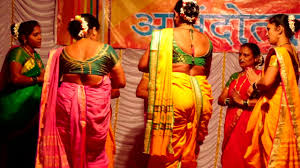Puppetry-No more a Dying Art
Additionally, India is famous for the oral culture and tradition that it possesses. Oral tradition is the means by which all art forms of texts are passed down from one generation to the next or from one person to another. The Gurukul system of Veda parayana was founded on this orality of oral transmission, which served as its foundation. The same can be said for the forms of folk art. The household of the folk art performer serves as a live gurukul, and the more experienced members of the troupe serve as a live guru—that is, a teacher who helps the younger members of the troupe learn the art form with zeal. The same thing is true when applied to more conventional forms of puppetry as well.
Dance performed with puppets; also called "Putul Nach," "Bombeyata," "Bommalata," and "Bommalattam." Because of the combination of its visuals, motions, and the ability to tell a story, "Pavai Koothu" and other similar forms of entertainment were once the most popular form of entertainment in rural areas, particularly among children. Puppeteers portrayed stories from Puranas, mythologies, of rural heroes, heroic stories, and people, their lifestyles, religious beliefs, and rural cultures, and much more using glove/hand puppets, string puppets, rod puppets, and shadow puppets respectively.
It is believed that India was the cradle of puppetry and that all four primary types of puppetry are still practiced there even today. It is a pitiful state of affairs that this art form, which is the mother of all other art forms, is considered to be "dying" as an art form.
Sadly, this particular form of artistic expression is rapidly becoming extinct. Puppetry's lack of popularity can be attributed, in part, to the absence of patronization, modernism, and the advent of and acclimatization to new forms of urban culture. Additionally, the public's lack of interest in this art form can be attributed, in part, to their fascination with the hidden world as well as the explosive growth of the technological industry. Due to the rapid pace at which lifestyles have evolved, many of our more time-honored occupations and pastimes have been relegated to the history books.
On the one hand, we have moved away from the conventional cultural ethos of the modern age and have embraced traditional cultural ethos. On the other hand, we have eradicated or are on the verge of eradicating cultural values, practices, belief systems, norms, folklore, storytelling, and so on. Where exactly are we going to march? Why are we moving forward despite the fact that it will result in the extinction of our own diverse folk art forms? The traditional art form of puppetry is no longer practiced in India, as it is in the majority of other developing countries as well. Puppetry, much like other forms of folk art, is now considered to be an art form that is on its way out.
Strangely, there are large numbers of people who are unaware of what a puppet is, where they are employed, or how they should be defined. The majority of Hollywood films, cartoons, animations, and monster movies make use of robotics. Furthermore, it is common to practice having puppets of supernatural or extraterrestrial beings made into films and recreated with graphics and animations so that they can "move in space." One doesn't actually see the puppet themselves, but rather the effects that it has.
The use of puppetry as a communication medium is particularly effective for rural audiences. It is possible to convey messages of health, hygiene, and family planning in a manner that is grounded in reality. Making and performing with puppets can be beneficial to occupational therapy for people with physical disabilities. The more work you put in, the better your muscular coordination and manual dexterity will become. Analyzing the comments that children make about what they see is another method for performing psychoanalysis on children.
As long as there are imaginative people who are deeply committed to the puppetry art form, it is highly unlikely that the art of puppetry will ever completely perish.
A recent, research baseline study conducted claims, that there are many women both from traditional and contemporary families who have a passion for Puppetry and are doing fabulous work. To name a few: Dr. Bhanumathi from Pavai center, Chennai, Smt. Seetalakshmi traditional leather puppeteer, Smt. Anupama Hoskere, Founder of Dhaatu Puppet theatre, Bengaluru, Padmashree Smt. Moozhikkal Pankajakshi and granddaughter K. S. Ranjini of Nokku Vidya Pavakali (a unique puppet play), Kerala, Ms. Ranjana Pandey from New Delhi and Ms. Anurupa from Katkatha, New Delhi, Smt. Pushpalatha Pulavar, Smt. Dalawai Rangamma-senior most leather puppeteer from Nimmalkunta, Shinde Subhadra, and Shinde Venkatamma –SNA awardee from Nimmalakunta, Anantapur District, Andhra Pradesh, Mothe Sayamma of Chekka Bommalata troupe from Burugupeta, Warangal, one and only women’s puppet troupe of Mulbagal, Kolar district of Karnataka with Smt. Padmamma Achar as team leader, Meena Naik, Chaitali Majgoankar, Deepali Babaoolkar, Ragini Sonam, Ranjana Kanitkar, Soniya Ketkar, Supriya Gosavi from Maharashtra, Dr. Moushami Chatterjee from Assam, Chandini Zala from Gujarat and many others.
Apart from this, the Mumbai university has started a certificate course in Puppetry in 2012 and this year UNIMA India has designed a Master's class Course in puppetry.
Puppetry is evolving constantly--what it is not what it was. The wheel is constantly being reinvented with sustaining force.
Today is the day to remember Dzhivada Zolfagariho from Iran who proposed World Puppetry Day at the XVIII Congress of the Union International de la Marionnette (UNIMA) in Magdeburg in 2000 to declare March 21st as World Puppetry Day The idea was accepted only two years later at the meeting of the International Council of UNIMA in Atlanta. The holiday was observed in 2003 for the first time. Since then World Puppetry Day is annually observed on March 21.






























Comments
Thanks for your valuable comment. Yes, I do see Puppetry getting noticed well with youth and in mass media.